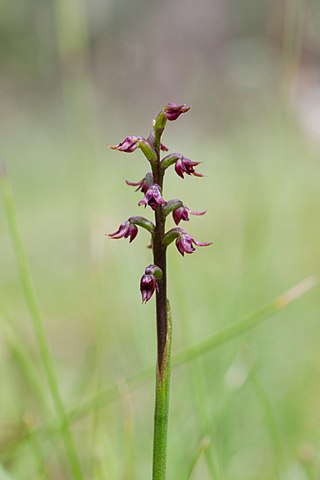
Genoplesium nudum, commonly known as the tiny midge orchid in Australia or the red midge orchid in New Zealand, is a small terrestrial orchid native to south-eastern Australia and New Zealand. It has a single thin leaf fused to the flowering stem and up to forty small, reddish-purple or green and red flowers. Australian and New Zealand authorities use the name Corunastylis nuda but Genoplesium nudum and Prasophyllum transversum are used by the World Checklist of Selected Plant Families.

Genoplesium filiforme, commonly known as the glandular midge orchid is a small terrestrial orchid endemic to the east coast of Australia. It has a single thin leaf and up to thirty greenish to purple flowers with a reddish-purple labellum. The edges of its flower parts are covered with many short glandular hairs. It is found from southern Queensland to southern New South Wales.

Genoplesium morrisii, commonly known as the bearded midge orchid and known as Corunastylis morrisii in Australia, is a small terrestrial orchid endemic to south-eastern Australia. It has a single thin leaf fused to the flowering stem and up to fifteen small, dark purplish-black or green and purple flowers.
Genoplesium acuminatum, commonly known as the pointed midge orchid, is a small terrestrial orchid endemic to eastern Australia. It has a single thin leaf fused to the flowering stem and up to sixteen small, hairy, greenish purple to brownish purple flowers. It is found in coastal and near-coastal parts of New South Wales and Queensland.
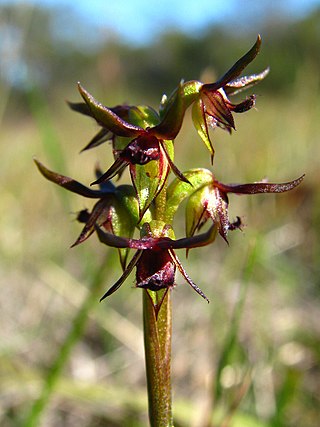
Genoplesium archeri, commonly known as the elfin midge orchid and as Corunastylis archeri in Australia, is a small terrestrial orchid endemic to south-eastern Australia. It has a single thin leaf fused to the flowering stem and up to fifteen small, hairy, yellowish green flowers with purple stripes. It grows in a wide range of habitats in New South Wales, Victoria and Tasmania.
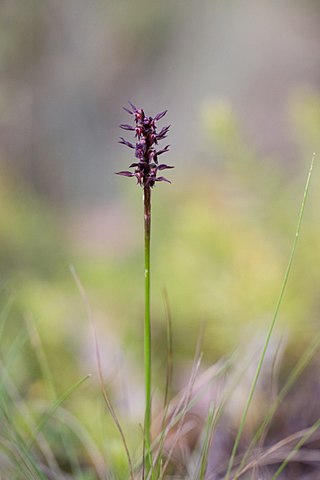
Genoplesium arrectum, commonly known as the erect midge orchid and as Corunastylis arrecta in Australia, is a small terrestrial orchid endemic to south-eastern Australia. It has a single thin leaf fused to the flowering stem and up to twenty small, dark purple flowers. It grows in a montane and subalpine grassland and forest in Victoria and the Australian Capital Territory.
Genoplesium capparinum, is a small terrestrial orchid endemic to Victoria. It is one of the midge orchids and has a single thin leaf fused to the flowering stem and up to twenty small, green flowers with purple markings. It is a rare species, found only in a small area in the south-east of the state.
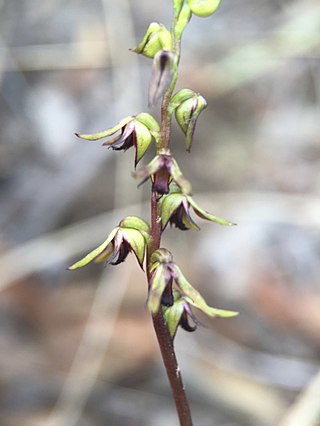
Genoplesium clivicola is species of small terrestrial orchid that is endemic to south-eastern Australia. It has a single thin leaf fused to the flowering stem and up to twenty five small, greenish and reddish flowers. It grows in forest and woodland in Victoria, the Australian Capital Territory and New South Wales.
Genoplesium cranei, commonly known as the Blackall Range midge orchid, is a small terrestrial orchid endemic to the Blackall Range in Queensland. It has a single thin leaf fused to the flowering stem and up to twenty small, green to greenish yellow flowers with reddish markings. It grows in open forest with shrubs and grasses.

Genoplesium ectopum, commonly known as the Brindabella spider orchid or ectopic midge orchid and as Corunastylis ectopa in Australia, is a small terrestrial orchid endemic to the Australian Capital Territory. It has a single thin leaf fused to the flowering stem and up to thirty five small, green and reddish purple flowers. It is only known from the Brindabella Range where it grows in Eucalyptus forest.
Genoplesium firthii, commonly known as Firth's midge orchid, is a species of small terrestrial orchid endemic to Tasmania. It has a single thin leaf fused to the flowering stem and up to six small, yellowish green or reddish flowers with a red labellum. It grows in coastal heath and scrub and is currently only known from a single population of about twelve plants near Coles Bay.
Genoplesium formosum, commonly known as the Cathcart midge orchid is a small terrestrial orchid found in southern New South Wales. It has a single thin leaf and up to twenty five dark reddish purple flowers with darker lines.
Genoplesium insigne, commonly known as the dark midge orchid or Wyong midge orchid is a species of small terrestrial orchid that is endemic to New South Wales. It has a single thin leaf and up to twelve dark purple to dark reddish purple flowers. It is mostly found in heath on the Central Coast and only around fifty plants survive.
Genoplesium morinum, commonly known as the mulberry midge orchid, is a species of small terrestrial orchid that is endemic to New South Wales. It has a single thin leaf fused to the flowering stem and up to twenty crowded, dark reddish purple flowers. It has been known as "mulberries on sticks".
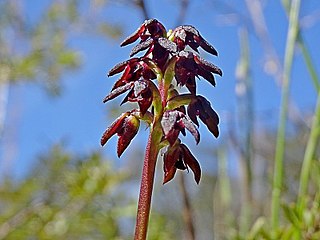
Genoplesium vernale, commonly known as the spring midge orchid or East Lynne midge orchid is a small terrestrial orchid which is endemic to a small area on the south coast of New South Wales. It has a single thin leaf and up to twenty five dark purplish-black flowers with tiny glandular hairs on the sepals and petals.
Genoplesium simulans, commonly known as the Blue Mountains midge orchid is a small terrestrial orchid which is endemic to New South Wales, where it mainly occurs in the Blue Mountains. It has a single thin leaf and up to twenty three dark purplish-black flowers which lean downwards.
Genoplesium leptochilum is a small terrestrial orchid endemic to Victoria. It has a single thin leaf fused to the flowering stem and up to twenty small reddish-brown to dark purplish flowers. It is known from one population with only six plants in forest near a swamp.
Genoplesium carectum is a species of small terrestrial orchid endemic to a restricted part of New South Wales. It has a single leaf fused to the flowering stem and between three and thirteen brownish-green flowers with purple and red markings. It occurs in three populations in swampy places in and near Wollemi National Park.
Genoplesium cuspidatum is a species of small terrestrial orchid endemic to eastern Australia. It has a single leaf fused to the flowering stem and between 6 and 28 reddish to dark purple flowers with prominent darker stripes.
Genoplesium stephensonii, commonly known as Stephenson's midge orchid, is a species of small terrestrial orchid that is endemic to the south-east of New South Wales. It has a single leaf fused to the flowering stem and usually up to five green flowers with pink to reddish markings.







